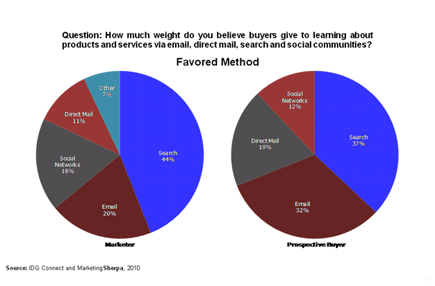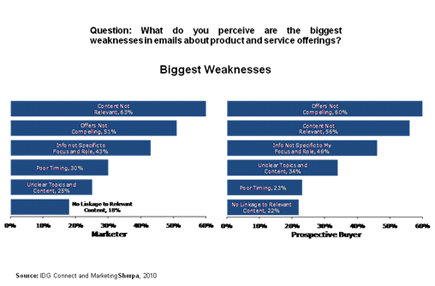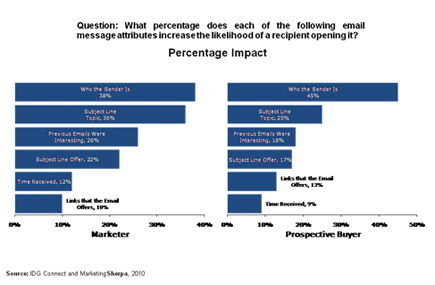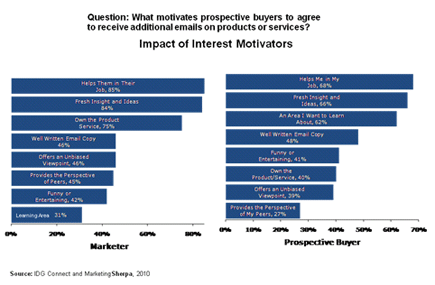The good news for B2B marketers is that buyers still consider email one of the most valuable sources of product and services information during a purchase process.
But to make the most of this opportunity, marketers need to understand what makes buyers more likely to sign up for (and open emails from) vendors -- and what buyers say are the biggest weaknesses in the emails they currently receive.
The data below helps answer such questions. In partnership with MarketingSherpa, Bob Johnson fielded two surveys on the subject of B2B marketing email. One asked buyers about specific factors that motivate them to receive, open, or engage with vendor email. The second presented the same questions to B2B marketers, but asked them to specify what they believed motivated buyers who receive their emails.
The gaps between what buyers say and what marketers believe represent great areas for potential improvement. Here are four insights Johnson offers from the data on what motivates buyers to receive and open email:
Insight #1. Buyers rely on email more than marketers think View larger version
View larger versionMarketers and technology buyers both identified search and email marketing as the two most valuable channels for receiving information about products and services. But marketers are underestimating how much weight buyers still place on information delivered through email -- especially compared to social networks.
- 32% of buyers said email was their favored method for receiving product/services information, compared to 20% of marketers who believed email was a buyer’s favored method.
- Only 12% of buyers said social networks were their favored method of receiving information, compared with 18% of marketers.
So, if you’re working to integrate social media into your lead-generation strategy, don’t assume that social media activity can replace email outreach. Johnson’s research has found that buyers tend to use social media most heavily at two stages of the buying process:
o General education
o Business-case development
In and around these stages, well-timed emails that deliver relevant content, and offers that prompt prospects to take an action, are crucial touches that help move them to sales-ready status.
Insight #2. Provide offers that direct readers to take the next step View larger version
View larger versionUnderwhelming offers are the biggest weakness of most emails, according to buyers. Marketers also identified lack of compelling offers as a significant weakness, though with less emphasis than buyers.
The effort to provide relevant content in an email message might cause marketers to overlook the importance of tying content to a compelling offer. In this case, Johnson says, the offer should be a call-to-action that offers a clear next step -- or options for next steps -- that helps readers build understanding of an issue, and to make buying decisions.
"Marketers can always ask themselves if the email represents an island, in that there are not different directions the user can move as a result of reading it," says Johnson.
Insight #3. Personalized sender information can increase engagement View larger version
View larger versionBuyers cited "known sender" as the most important factor in determining whether or not they open an email. But making the most of this opportunity means more than just using your company’s name in the "from" line, says Johnson.
Marketers should consider personalizing B2B email communications with an individual’s name -- preferably, a name connected to a particular business area, job function or area of expertise that’s most relevant to the prospect. For example, emails aimed at IT prospects could come from a member of the organization’s technical staff. Likewise, emails related to a specific business function, such as finance, should come from a team member who is an expert in those topics.
In fact, marketers may be able to increase their email communication with prospects by using multiple personalized senders. When the survey asked about senders from which buyers were most likely to open emails, two different types of vendor personnel were ranked #2 and #3 (behind industry peer):
o Vendor subject matter expert
o Vendor product/service support
"You are trying to build up individuals to have not a guru status, but some level of personal contact," says Johnson.
Insight #4. Appeal to buyers’ personal, not just organizational, motivations View larger version
View larger versionMarketers and buyers were largely on the same page when it came to naming specific factors that motivate buyers to receive more email from a vendor. Both groups picked the same factors as the top two motivators:
o Email that helps buyers in their jobs
o Email that offers fresh insight and ideas
But pay close attention to buyers’ third ranked choice: An area I want to learn about.
This response reflects the importance of personal and professional aspiration in buyers’ decision-making processes. "Buyers want to do good job for the organizations work for, but they’re also looking out for number one," says Johnson. "So much of an investment decision, no matter how rational and practical people say it is, is really more emotional."
By contrast, marketers ranked personal learning areas dead last as a motivator. The discrepancy represents a common mistake often made by marketers, says Johnson. They tend to focus email copy and content on the benefits offered to a buyers’ organization, rather than to the buyer him- or herself.
Look for opportunities to frame product and service descriptions around the personal benefits a buyer will reap -- or the threats and concerns they face. For example:
o Presenting concerns in a peer-to-peer manner -- "Did you know that 65% of IT managers are concerned about X?"
o Highlighting managers’ personal responsibility for inefficient processes or system downtime
o Describing how managers can benefit when they improve their department’s efficiency and financial performance
Next week: Data that describes how buyers react to different content and offer types.Useful links related to this articleSummit Wrap-up Report: 7 Takeaways to Improve your Email Marketing in 2010
http://www.marketingsherpa.com/article.php?ident=31519
IDG Connect
http://www.idgconnect.com/













